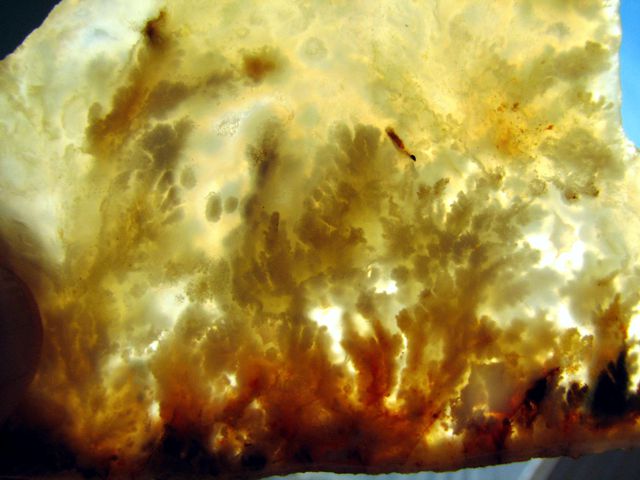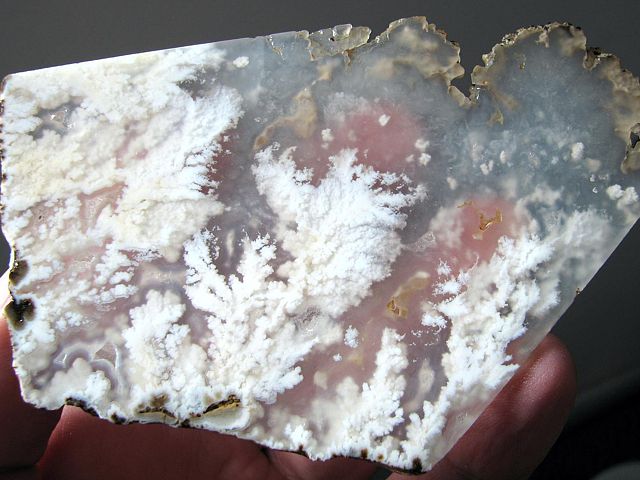|
|
Post by rockjunquie on May 5, 2019 20:56:40 GMT -5
I know why people cut really thin slabs- to make money. But, why are all the nice plumes and fancy included agates always, as a general rule, so damn thin? I get it that they want to make money, but I don't like them backed. I don't want colored or white or black. I just want to cab the agate. What do people generally do? Do they back them with glass or clear agate? I have fallen in love with a bunch lately, but they are like 3mm thick.  That means so much extra work that I don't know if I can make my money back. The nice agate slabs ain't cheap, either. Color me frustrated. |
|
QuailRiver
fully equipped rock polisher
  
Member since May 2008
Posts: 1,640
|
Post by QuailRiver on May 5, 2019 23:27:31 GMT -5
The concentration of plumes in agates can be such that if the slab is a normal cabbing thickness it has more of a moss agate appearance than it does a plume agate. A thinner slab can show-off the plumes better.
And some folks do use clear quartz over thin plume slabs to make cabs.
Larry C.
|
|
Fossilman
Cave Dweller 
Member since January 2009
Posts: 20,718 
|
Post by Fossilman on May 6, 2019 9:05:57 GMT -5
The only agates I cut thin, are the Montana moss agates... Not every slab though..
|
|
|
|
Post by rockjunquie on May 6, 2019 9:16:00 GMT -5
The concentration of plumes in agates can be such that if the slab is a normal cabbing thickness it has more of a moss agate appearance than it does a plume agate. A thinner slab can show-off the plumes better. And some folks do use clear quartz over thin plume slabs to make cabs. Larry C. Thank you for that. So, it is more common to make a doublet rather than back them? I have some very thin ones that someone had been using to back. Very, very thin, like less than 2mm. Almost seems like a triplet would be best. |
|
|
|
Post by rockjunquie on May 6, 2019 9:16:15 GMT -5
The only agates I cut thin, are the Montana moss agates... Not every slab though.. How do you use them? |
|
Deleted
Deleted Member
Member since January 1970
Posts: 0
|
Post by Deleted on May 6, 2019 11:52:54 GMT -5
So, it is more common to make a doublet rather than back them? I have some very thin ones that someone had been using to back. Very, very thin, like less than 2mm. Almost seems like a triplet would be best. More common to just cut them as tablets (or very low domes) usually on flats instead of on wheels. Girdle bevels are either very shallow, or just skipped. I have bought some smaller pieces that are less than 0.5 mm thick - wonderfully light, but you are correct that it must take developing some skill and nerves to get confident of not snapping something THAT thin during sanding. Smooth initial cut is important, as there's little or no room for using any of the coarse grits (you'll never get the scratches out). Not something to try with fragile material with partially healed cracks or porous areas (if doing those, that is when doublets or triplets become options). Other translucent materials with patterns, such as Midnight Lace obsidian, also look better - amazingly better - when cut thinner with shallow or no dome. |
|
|
|
Post by rockjunquie on May 6, 2019 12:29:39 GMT -5
So, it is more common to make a doublet rather than back them? I have some very thin ones that someone had been using to back. Very, very thin, like less than 2mm. Almost seems like a triplet would be best. More common to just cut them as tablets (or very low domes) usually on flats instead of on wheels. Girdle bevels are either very shallow, or just skipped. I have bought some smaller pieces that are less than 0.5 mm thick - wonderfully light, but you are correct that it must take developing some skill and nerves to get confident of not snapping something THAT thin during sanding. Smooth initial cut is important, as there's little or no room for using any of the coarse grits (you'll never get the scratches out). Not something to try with fragile material with partially healed cracks or porous areas (if doing those, that is when doublets or triplets become options). Other translucent materials with patterns, such as Midnight Lace obsidian, also look better - amazingly better - when cut thinner with shallow or no dome. Thanks! I can cab pretty thin and I have a flat lap if I am forced to use it or even wet/dry sandpaper, but what I am wondering is how does one use something so thin? |
|
Deleted
Deleted Member
Member since January 1970
Posts: 0
|
Post by Deleted on May 6, 2019 13:01:50 GMT -5
...what I am wondering is how does one use something so thin? For smaller stones, they usually get set into collets; for larger stones, bezel settings with the back cut out; basically any open-backed setting design where the stone is being framed. I'd think wire wrap would work equally well for larger pieces, just as for other transparent pieces - bearing in mind that you'd see the wire from both sides. I've seen some that have been framed using electroforming, too. However, I personally find thin, transparent tablets that get set using prongs distracting (the basket or whatever underneath is more visible through transparent tablet stones than in faceted or domed stones). At least those are what come to mind... perhaps there are other ideas out there anyone? |
|
|
|
Post by stardiamond on May 6, 2019 16:49:55 GMT -5
Some years ago, I bought Stinkingwater plume slabs from a seller. I've tried buying rough and the plumes were too dense. I like a lot of agate with plume mixed in not a bunch of plume. Some day I'll try slicing it thinner to see if that helps.
|
|
Deleted
Deleted Member
Member since January 1970
Posts: 0
|
Post by Deleted on May 6, 2019 17:19:39 GMT -5
Stinkingwater Plume is a good example. I don't have any photos of adjacent slabs, but these were similar enough to show the difference. A bit more color in one vs. the other (including the color of the light at different times of day), but how well the pattern displays is the point. Photos from front and backlit... around 5mm thick   around 2.5mm thick   As with slabs, the plume starts to disappear in thicker cabs. |
|
|
|
Post by rockjunquie on May 6, 2019 17:23:02 GMT -5
Stinkingwater Plume is a good example. I don't have any photos of adjacent slabs, but these were similar enough to show the difference. A bit more color in one vs. the other (including the color of the light at different times of day), but how well the pattern displays is the point. Photos from front and backlit... around 5mm thick   around 2.5mm thick   As with slabs, the plume starts to disappear in thicker cabs. That really makes the point! |
|
goatgrinder
spending too much on rocks
  Make mine a man cave
Make mine a man cave
Member since January 2017
Posts: 368 
|
Post by goatgrinder on May 6, 2019 17:29:35 GMT -5
Wow! The back lighting really does make the point. I get it now. Thanks.
|
|
Deleted
Deleted Member
Member since January 1970
Posts: 0
|
Post by Deleted on May 6, 2019 17:37:23 GMT -5
That really makes the point! Still can be nice material when thicker, just has a lot more impact when thinner. Though my experience in selling isn't all that great, the thinner plume slabs and cabs photograph more easily, sell quickly and sell for more. Thicker ones just sit around for longer. My remaining saw won't slab that thinly - gotta take care that thin pieces don't break off and jam the works. Though most looks better thin IMO, some plume may be loose enough, and in chalcedony that's transparent enough, that thickness isn't an issue. |
|
QuailRiver
fully equipped rock polisher
  
Member since May 2008
Posts: 1,640
|
Post by QuailRiver on May 7, 2019 0:46:10 GMT -5
The concentration of plumes in agates can be such that if the slab is a normal cabbing thickness it has more of a moss agate appearance than it does a plume agate. A thinner slab can show-off the plumes better. And some folks do use clear quartz over thin plume slabs to make cabs. Larry C. Thank you for that. So, it is more common to make a doublet rather than back them? I have some very thin ones that someone had been using to back. Very, very thin, like less than 2mm. Almost seems like a triplet would be best. Just depends on the look you're going for. Some folks like the colored backings. And I agree that with some of the white plumes a colored or black backing can help give some contrast to show the plumes better. But for most non-white plumes IMHO they usually look better without a colored backing. As for those 2mm thick plume agate slabs, if your gut tells you that they may require some back support too, then there is no reason a triplet couldn't be made with both a clear quartz cap and a clear quartz backing but the clear quartz is going to have to be really thin slices too unless you're going for really high domed cabs. Larry C. |
|